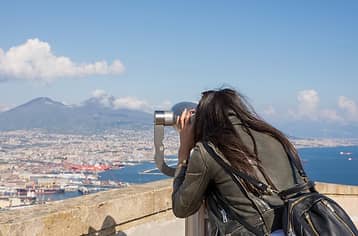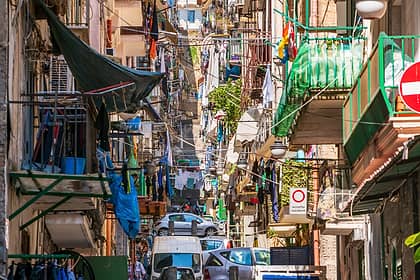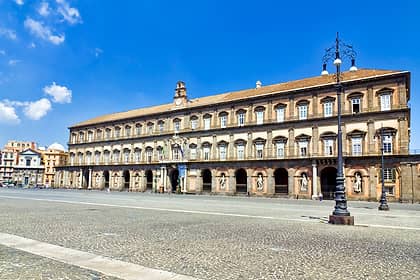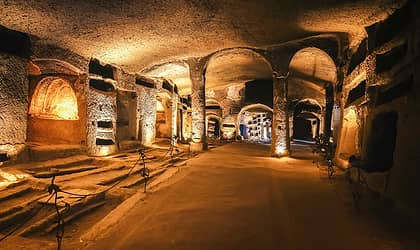- Home
- Top 10 Things to See in Naples - The Ultimate Guide
Top 10 Things to See in Naples - The Ultimate Guide

Is Naples worth a visit? Absolutely! This city in southern Italy has a history that stretches back more than 2,000 years and is rich in ancient ruins, baroque palaces, and world-class artwork, plus has one of the most captivating historic centers in Italy.
It’s not easy to cover all of the city’s gems during a short visit, but this guide will help you focus on the top sights to explore the best of Napes in just two or three days before or after you check out the Amalfi Coast. From the imposing Castel Nuovo (Maschio Angioino) and Cappella Sansevero with its stunning statue of the Cristo Velato, to the bustling warren of streets in the old town and sweeping confines of Piazza del Plebiscito, here are the top 10 sights to check out in Naples (plus a bonus suggestion just outside the city).
Get ready to explore La Bella Napoli, but make sure you wear comfortable shoes because you’ll be doing a lot of walking!
1. The Historic Center of Naples
1. The Historic Center of Naples

The historic center of Naples is a UNESCO World Heritage Site and one of the largest and most densely populated old towns in Europe. You can walk its entire length along the lively Spaccanapoli thoroughfare that cuts through its heart, dividing the old town in two, and Via San Gregorio Armeno, famously lined with artisan workshops that produce the city’s traditional “presepe” (nativity scenes). Stop in Piazza San Domenico Maggiore or Piazza del Gesù Nuovo for a bracing espresso, a sweet sfogliatella, or one of the city’s many street-food delicacies! Just outside the district known as the Decumani, step onto Via Toledo, the busiest shopping street in Naples that leads to Piazza Plebiscito, Galleria Umberto I, and the San Carlo opera house; the narrow side streets that climb the hillside above Via Toledo lead to the gritty yet atmospheric Quartieri Spagnoli (Spanish Quarters).
While exploring the historic center, make sure you find time to explore its top three attractions: Naples Underground; the “Veiled Christ” in the Sansevero Chapel, and the Cloister of Saint Claire.
Authentic Neapolitan Pizza
Naples is the birthplace of pizza, so there’s no better place to feast on the best pizza in the world than in one of the many landmark pizzerias in the historic center. The most famous are Sorbillo and da Michele, but there are endless options for sampling unforgettable “pizza napolitana”!
2. Naples Underground
2. Naples Underground

Hidden beneath the modern streets of Naples hides another historic city: Naples Underground (Naples Underground), a network of ancient tunnels, chambers, and passageways that run under the historic center. One of the largest and most complete underground urban areas in the world, Napoli Sotteranea includes more than 40 miles of tunnels. The network was created by the ancient Greeks to extract stone to use as building materials as the city grew, but was expanded by the Romans and later by the Bourbons to be used as an aqueduct to bring water to the city’s residents. The area was later expanded to include storage rooms, escape routes, and even a bomb shelter. Join a guided tour of Underground Naples to explore the tunnels by candlelight. The entrance is located along Via dei Tribunali in Piazza San Gaetano.
Visit Naples Underground
3. The Veiled Christ (Sansevero Chapel)
3. The Veiled Christ (Sansevero Chapel)

While exploring the historic center of Naples, be sure to schedule in time to stop at the Chapel of Sansevero to marvel at the Veiled Christ. This marble statue by the Italian artist Giuseppe Sanmartino is considered one of the great masterpieces of 18th-century neoclassical sculpture and depicts Christ wrapped in a shroud, with his face hidden from view. The work was commissioned by the Duke of San Severo, an alchemist from the 1700s, and will stop you in your tracks with its otherworldly detail and realism. The chapel holds a second famous Sanmartino sculpture, the Anatomical Mannequin, a model of the inside of a human body believed to represent the Duke's murdered brother.
The Sansevero Chapel: Opening Hours and Information
4. Santa Chiara Monastery
4. Santa Chiara Monastery

The Monastery of Santa Chiara (Complesso Monumentale di Santa Chiara) is a peaceful retreat from the bustling city of Naples. This gothic monastery was founded in 1313 and quickly became an important center of culture and learning; today its museum houses an impressive collection of 14th-century art and artifacts. Explore the museum, library with over 30,000 volumes, and the picturesque cloister gardens, completely decorated in ornate hand-painted majolica tiles and benches.
5. The Royal Palace of Naples and Piazza Plebiscito
5. The Royal Palace of Naples and Piazza Plebiscito

The Royal Palace (Palazzo Reale) and adjacent Piazza del Plebiscito are two of the most recognized landmarks in Naples. The Palazzo Reale was the largest building in Europe when it was built in the 17th century and remains the largest palace in Italy, home to numerous important works of art. Piazza Plebiscito is one of Naples’ main squares of Naples; it was here that a vote was taken in 1860 that led to the country’s unification, a historic event for which the square is named. This symbol of Naples often plays backdrop to concerts and major events.
Visit the Royal Palace in Naples
From Piazza del Plebiscito, stroll along Via Chiaia to Piazza dei Martiri, one of the city’s most beloved public spaces, lined with cafés. Continue on along the seafront promenade, another symbol of Naples and a popular spot for an evening stroll.
6. Castel dell’Ovo
6. Castel dell’Ovo

The postcard-perfect Castle dell’Ovo is perhaps one of the most photographed sights in Naples. Perched on an islet just off the city’s coast (and connected by a bridge), this castle is the subject of a colorful legend: it is said that the poet Virgil ordered that an egg should be placed beneath the castle foundations to symbolize its strength. True or not, Castel dell'Ovo has withstood centuries of wars and earthquakes and is open to the public for guided tours and temporary exhibitions.
After taking in Castel dell’Ovo, stop for a heaping plate of spaghetti con le vongole at one of the traditional seafood trattorias in Borgo Marinari (the hamlet set just below the castle). Afterwards, burn off your carbs with a walk along the charming Via Caracciolo to admire the sweeping views over the Gulf of Naples.
7. Capodimonte Museum
7. Capodimonte Museum

One of the top museums in all of Italy, Capodimonte occupies an immense 18th-century palace built by Charles III, Duke of Bourbon and houses a vast collection of Renaissance paintings, porcelains, and sculptures. Admire works by Caravaggio, Rubens, Titian, Rembrandt, and Raphael before heading outside to stroll through the garden with spectacular views of Naples from above.
Visit the Capodimonte Museum
8. Catacombs
8. Catacombs

Among the city’s most fascinating sights, the catacombs of Naples are a network of ancient underground tunnels and chambers that were once used as burial sites. There are three main catacombs open to visitors in Naples: San Gennaro; San Gaudioso; and the Fontanelle Cemetery.
The Catacombs of San Gennaro are the largest and most popular catacombs, named for San Gennaro, the patron saint of Naples who was initially buried here (today the remains of the saint are housed in the city’s 13th-century Duomo). These catacombs date back to the third century AD.
The catacombs of San Gaudioso were dug in the 5th century AD and are named after San Gaudioso, the first bishop of Naples. The catacombs contain the remains of over 20,000 people, as well as many interesting works of art and architectural features.
The Fontanelle Cemetery is a much more recent burial site, built in 1656 to house the remains of the victims of plagues and wars. Today it contains the remains of about 40,000 Neapolitans.
9. The Naples National Archaeological Museum (MANN)
9. The Naples National Archaeological Museum (MANN)

The National Archaeological Museum of Naples (also known as MANN) contains one of the world’s most important collections of ancient Greek and Roman artifacts, including thousands of pieces unearthed during excavations of the ancient city of Pompeii and other nearby ancient sites, plus a number of important Egyptian artifacts. With over 20,000 pieces displayed, a visit here is a must-see for history buffs.
Visit the Archaeological Museum of Naples
10. Mount Vesuvius
10. Mount Vesuvius

The rumbling form of Mt. Vesuvius looms over Naples, a symbol of the city’s past and present and the only active volcano on the European mainland (Vesuvius last erupted in 1944). Venture to its volcanic peak for endless views over the Bay of Naples and a peak inside its massive steaming crater; you can visit on your own or join a group tour from Naples.
Visit the top of Mt. Vesuvius
Bonus: Pompeii
Bonus: Pompeii

Almost everyone who visits Naples takes a day trip to explore the ancient city of Pompeii. Set at the foot of Mt. Vesuvius, this lively Roman city was buried by a massive volcanic eruption in 79 AD, freezing it in time and offering visitors today a unique glimpse of daily life during the Roman Empire. There are a number of perfectly preserved villas, shops, theaters, temples, baths, and other structures, many of which still sport their original frescoes, mosaics, and other decorations. Be sure to check out the Forum, the city's main square, and the House of the Faun, one of Pompeii’s largest and most luxurious villas.
Visit the excavations-of-Pompeii from Naples
Visiting the Ruins of Herculaneum
If you love ancient history, you can also visit the ruins of the Roman city of Herculaneum. This site is also an excellent option if you have limited time as it is much smaller than Pompeii (though equally fascinating) and takes just a couple of hours to visit rather than a full day.
Visit Herculaneum
How to Get Around Naples
Though Naples is a large city that is quite spread out, the first attractions listed here are all within walking distance if you are staying in the center of Naples. To visit Pompeii, take the Circumvesuviana train; for Mt. Vesuvius you’ll need to drive or take the Circumvesuviana plus a bus. To move between different neighborhoods in Naples, the subway is the best option; a number of major stations (most notably Piazza Dante and Toledo) are also showcases of contemporary art. To reach neighborhoods and attractions in the hills above the city like Vomero and Castel Sant’Elmo, hop on the scenic funicular.
Ferries for the island of Capri, Ischia, Procida, and Sorrento regularly depart from the Naples port
How to get around Naples
Now that you have an idea of what you may want to see while visiting Naples, take a look at our step-by-step itineraries. These cover a sightseeing day trip (from Rome, Positano, or other Italian cities in Campania) or a longer stay:
FAQ - Frequently asked questions
Is Naples dangerous?
Naples is no more or less dangerous than other major Italian and European cities. Use the normal amount of caution when visiting (like avoid wearing expensive jewelry and watches and keep a close eye on bags and wallets) to guard against petty crime; violent crime against tourists is very rare. There aren't any particular neighborhoods to avoid in Naples, though you should take care around the train station and Piazza Garibaldi at night. Even the Quartieri Spagnoli, once known as Naples's grittiest district, is now full of tourists and safe to visit.
Which is the best area to stay in Naples?
The entire historic center and area around Via Toledo are ideal as a base for exploring Naples on foot. For more information, read our post here: Where to Stay in Naples
What should I buy in Naples?
The city has fabulous artisan crafts and delicious gourmet delicacies. Read more here: Top 10 Souvenirs from Naples.
When is the best time of year to visit Naples?
The best months to visit Naples are April and May or September and October. The Christmas season is also a fantastic time to experience the holiday atmosphere: The Best Time of Year to Visit Naples